
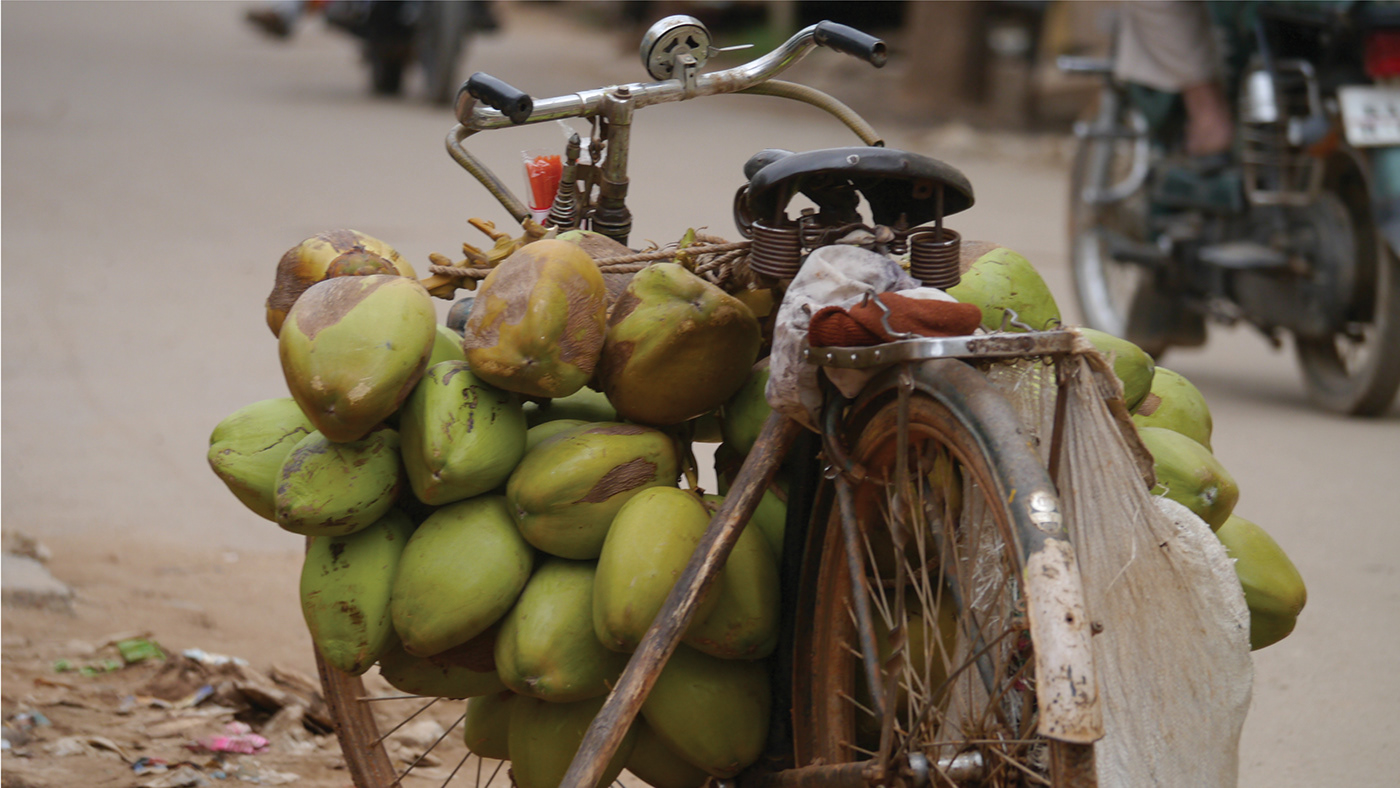
Why Business on wheels?
Business on wheels started with a thought about how people in India do business on an Atlas classic bicycle. This bicycle has the capacity to carry 2 people from one place to another. Over time, people have modified bicycles for carrying merchandise instead of people. In India, the unconventional modification or use of a particular product is popularly known as ‘jugaad’ (जुगाड़). Jugaad is an act of creativity in the most primitive form- “Solving a problem with the resources available to the user.”
While such modifications aid the users in carrying merchandise, they take away the basic function of a bicycle- to be able to ride it. Selling products on wheels has been flourishing in India since decades, but no specific effort has been taken, considering the unique requirements of an Indian vendor who does business on a bicycle.
This project is an effort towards making something the Indian street vendors are proud to own, at the same time uplifts their business by taking into consideration the problems that revolve around it.

Trends - towards an Eco-friendly future
1. Civil planning standards - Bicycle lanes
A Bike Lane is defined as a portion of the roadway that has been designated by striping, signage, and pavement markings for the preferential or exclusive use of bicyclists. Bike lanes enable bicyclists to ride at their preferred speed without interference from prevailing traffic conditions and facilitate predictable behavior and movements between bicyclists and motorists.
2. Civil planning standards - Car free zones
Car free zone is the most successful upcoming trend related to the bicycle industry. In certain happening areas, car traffic is restricted during certain hours of the day. For example- Time square, New York or Rock beach road, Pondicherry. This helps in easy flow of pedestrian traffic and avoids unnecessary traffic jams during peak hours.

Field study - Scope for business on bicycle in Bengaluru
Why aren’t more people not doing business on bicycle in indiranagar/koramangala?
Let’s start with why should people do business on bicycle in the above mentioned areas? Well the answer is simple. 1. These are happening areas with more foot flow and 2. Tourists of target age groups visit these areas plus cosmopolitan Koramangala is popular with young tech workers and students, due to the many IT companies and colleges in the area.
Now let’s come back to the original question. The most common reason is the distance from home and difficulties faced in riding a bicycle with loaded merchandise. While other riders are not aware about the opportunities in these areas. Some also complain that they get their merchandise from the central market which is very far away from these areas (10 km approx.).
While in other countries, people started doing business on a bicycle because it was an Eco-friendly & healthy solution resulting in a better lifestyle. For us, It was a need. We didn’t have means to have a motorized transport when all this started. Hence, we were left with no choice. If we develop a unit which vendors are proud to own, solving the problem for the existing vendors would be a first step towards a greater goal. We can actually attract a new generation of vendors to start an Eco-friendly business on wheels & in the process save the dying idea of doing business on a bicycle in India.

Design inspiration & CMF

Primary brief
Designing a tricycle with an aim to uplift the business of vendors by analyzing all the micro problems faced by them and provide a cost effective solution.
Secondary brief
Designing a contemporary experience with integrated traditional values & practices for the consumers & vendors alike.

What makes rath?
This tricycle is divided into certain parts which function together to give a seamless experience in terms of riding & business.
When you purchase the tricycle, it comes without any modular components. You have the liberty to either purchase an existing configuration or make your own combination. All the parts that play an important role in completing rath are listed below -
1. Tray holder
2. Cold storage
3. Main storage/ display
4. Special unit
5. Platform
6. Base & handle bar
7. Wheel layout & size
8. Frame
9. Garbage bag holder
2. Cold storage
3. Main storage/ display
4. Special unit
5. Platform
6. Base & handle bar
7. Wheel layout & size
8. Frame
9. Garbage bag holder


1. Tray holder (490x345x200)
This is the most versatile unit of the tricycle and can be useful to most vendors as a primary storage module. As the name suggests, it is a unit used to hold trays/ crates. Supreme makes variety of crates in different sizes. The length & width of the crate is restricted to 400x300 mm. The 400x300 series have different heights. The minimum height required for this unit is 65 mm. While the maximum can go to 275 mm as the side & bottom supports can be removed according to the requirement.
Available crate heights in 400x300 series-
A. 65 mm
B. 90 mm
C. 100 mm
D. 120 mm
E. 150 mm
F. 175 mm
G. 200 mm
H. 220 mm
I. 275 mm
B. 90 mm
C. 100 mm
D. 120 mm
E. 150 mm
F. 175 mm
G. 200 mm
H. 220 mm
I. 275 mm

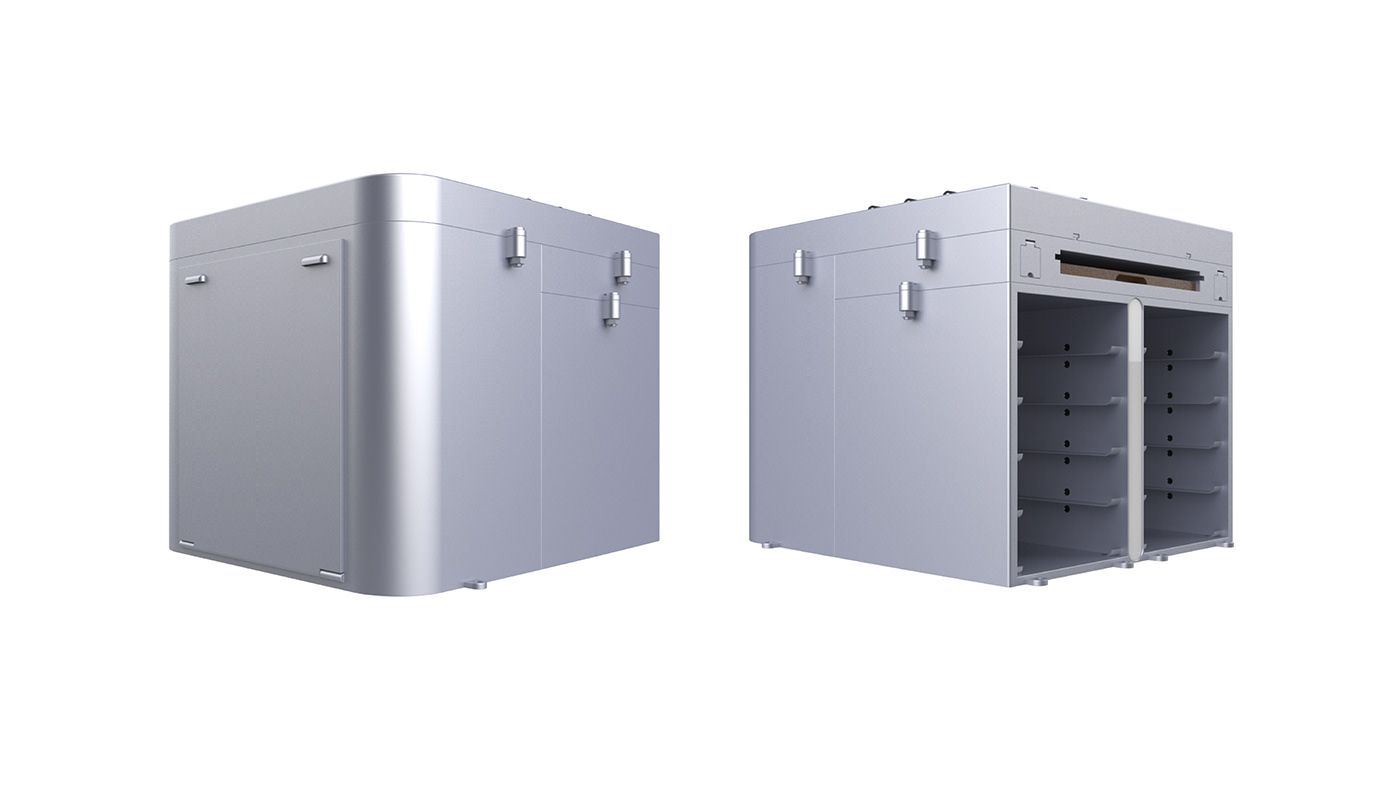


2. Cold storage (490x345x200)
Many vendors have to carry an ice box with them for various reasons. For example, a chai wala would require an ice box to store milk for the entire day. While a juice wala would require it for carrying ice. When thought about it, 2 solutions came up. One was to provide a tray holder and use it to carry the ice box around & another was to make a unit specially for cold storage. A special unit for the requirement makes it very easy to access the items stored inside it. Maximum capacity of this unit is 20 liters.
Some items that require cold storage-
1. Ice
2. Milk
3. Cut fruit
4. Vegetables
5. Sauces like mayonnaise
6. Cheese
2. Milk
3. Cut fruit
4. Vegetables
5. Sauces like mayonnaise
6. Cheese




3. Main storage (700x575x350)
Vendors who are not selling ‘ready-made’ items would require this unit to meet their power requirements. Whether it is a 5KG gas cylinder to cook Indian tea or a rechargeable battery to power a juicer. The positioning of the unit is also very important. In this case, it shares walls with the platform and the special unit making it very easy to supply gas or electricity to respective units. It can be also used to store an overhead umbrella which protects the merchandise & the vendor from harsh sun during the day.
Anything big should be stored in this container-
1. 5KG gas cylinder or smaller
2. Rechargeable battery
3. Huge umbrella
4. Cleaning equipment’s
5. Filled garbage bags for disposal/ unused garbage bags
2. Rechargeable battery
3. Huge umbrella
4. Cleaning equipment’s
5. Filled garbage bags for disposal/ unused garbage bags
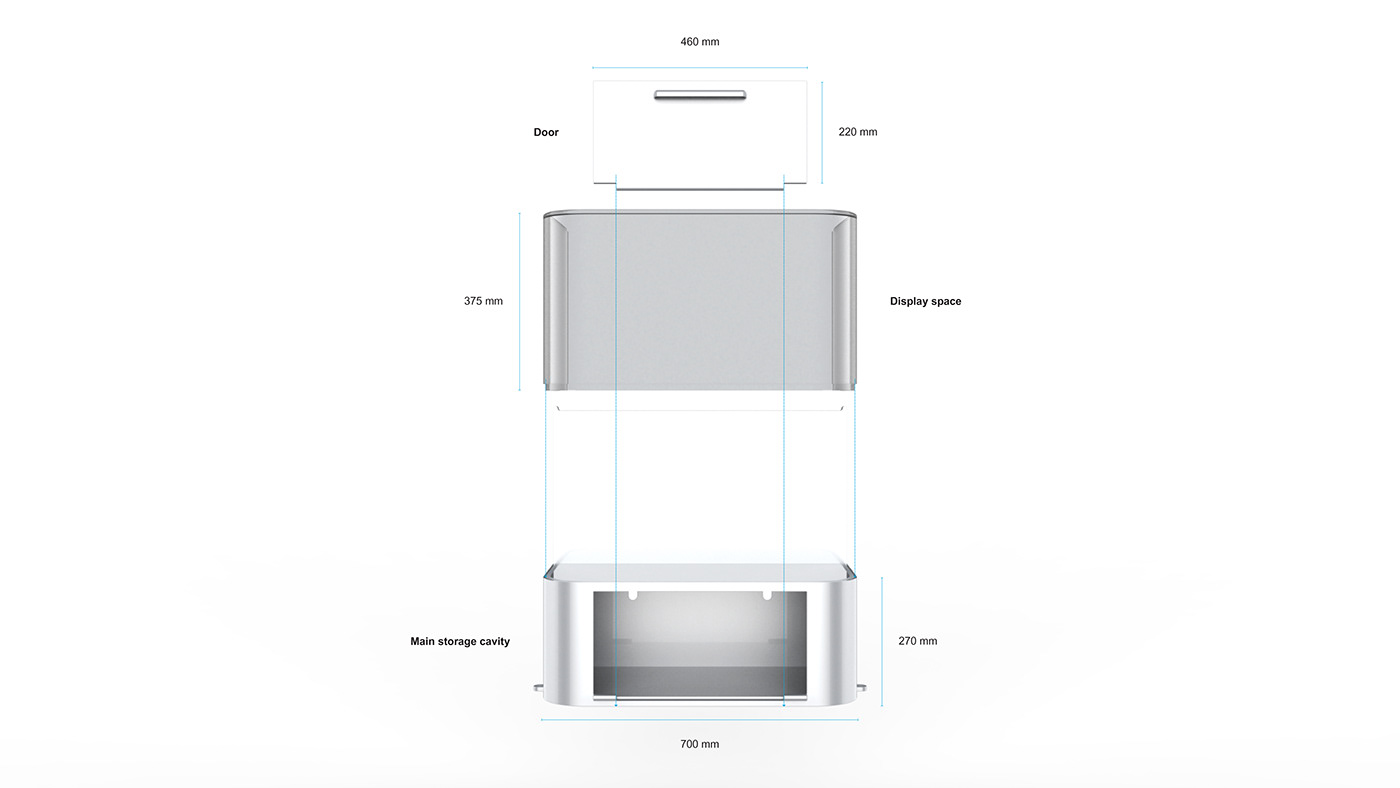
3.1. Main Display (700x575x350)
For some street vendors display is more important than having a menu. For example, a vendor selling fruit would want all the prospect consumers to have a look at the fruits he is selling. This also applies to vendors selling ice gola, milkshakes, juice etc. For such vendors, a variant of main storage unit was designed. This unit divides the area into display space & storage space. Display space is made out of reinforced transparent plastic giving consumers unrestricted view. The platform size has also been reduced in this unit giving priority to display. The size of the unit remains same as Main storage.
Finished products or ingredients can be used as a display-
1. Fruit variety
2. Flavor bottle for ice gola
3. Any ‘ready-made’ merchandise
2. Flavor bottle for ice gola
3. Any ‘ready-made’ merchandise






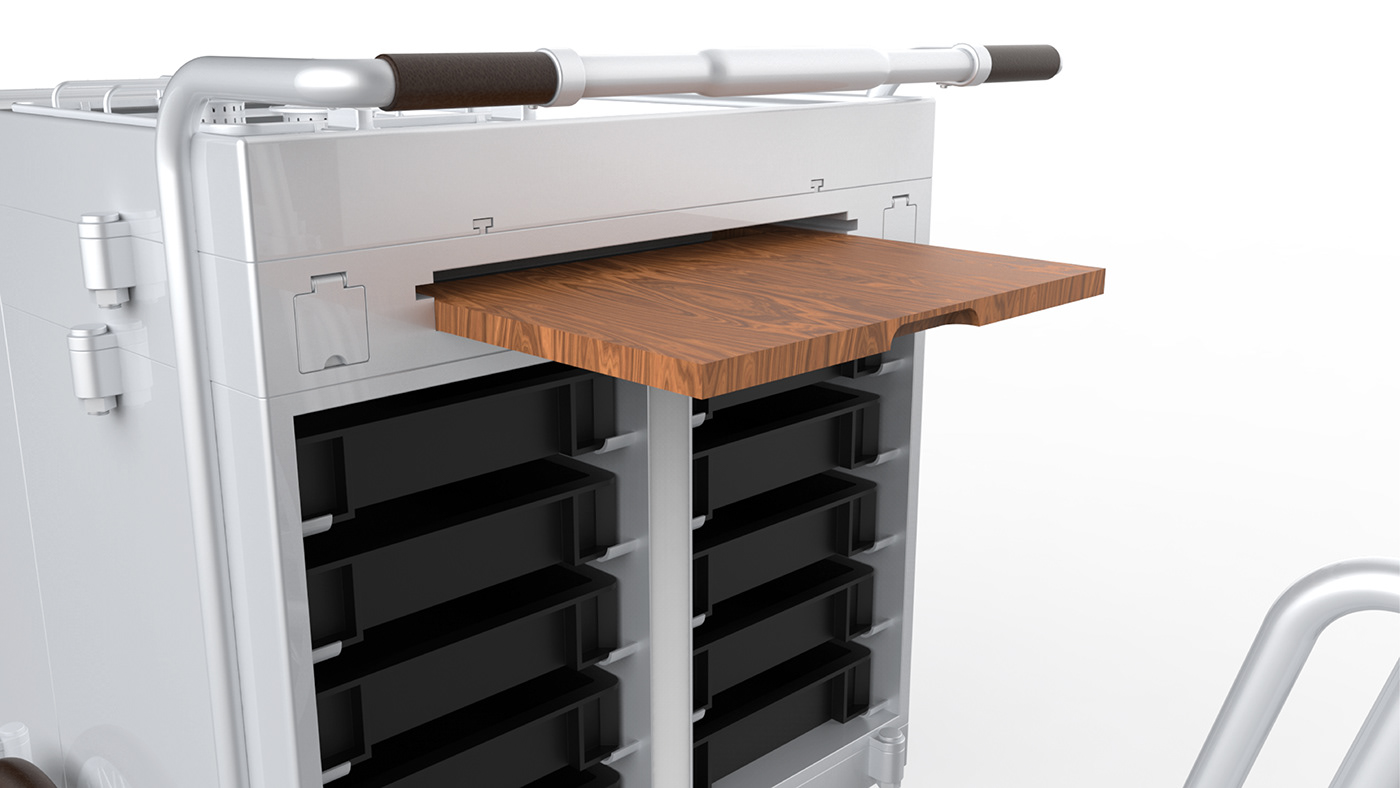

4. Special unit (700x440x85)
This part can be made according to the specific requirements of a vendor. For the part designed here, we took the vendors who require cutting vegetables or fruits as a part of their business into consideration. The unit contains retractable cutting board & 2 power sockets which can be used to charge a phone, power a juicer or can be used to power portable Wi-Fi devices. This can help the vendor provide a better experience to the customers. The positioning of the unit is exactly at the ergonomic work station height required by the 45 percentile Indian male/female. This will allow ease in cutting the ingredients without any discomfort.
This unit provides two utilities-
1. Power point (x2)
2. Retractable cutting board
2. Retractable cutting board



5. Platform (800x700x70)
This is the top most part of the assembly. It has enough surface area for a menu, stove (or equivalent) and place for people to eat like a standing table. Different equipment can be mounted on top of it as per requirements. It also has a hole which can be used to install an overhead umbrella to protect the vendors & merchandise from harsh weather. The menu is covered by a thin glass panel for clear visibility & long term preservation. This glass also acts as base for people to have a conversation while looking at the menu. The platform is set at 45 percentile ergonomic work station height for an Indian.
The standing work station height from the ground is 950 mm.
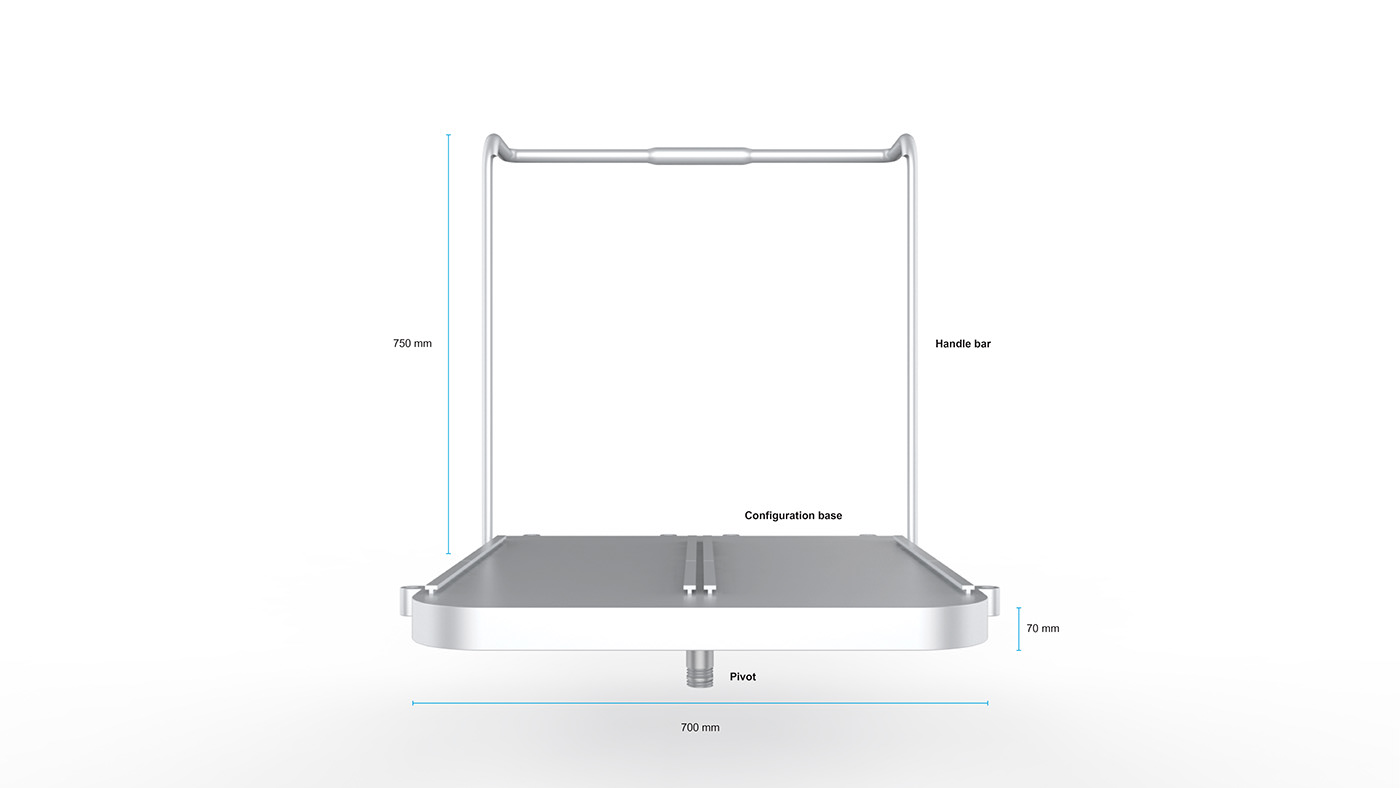
6. Base & handle bar (800x700x750)
The foundation of the entire assembly is the base unit. This unit holds the assembly together. Pivot point, which is a part of the base connects the business unit to the cycle unit & facilitates the turning of the tricycle. The handle bar is attached to the base & is 750 mm in height. The bottom of the base also features a 30 mm hollow cylinder used to pass a connecting element between the front wheels.
Important elements of base unit-
1. Sliding joint
2. Pivot point
3. Handle bar
4. Front wheel connection cavity
5. Part joinery cavities
2. Pivot point
3. Handle bar
4. Front wheel connection cavity
5. Part joinery cavities

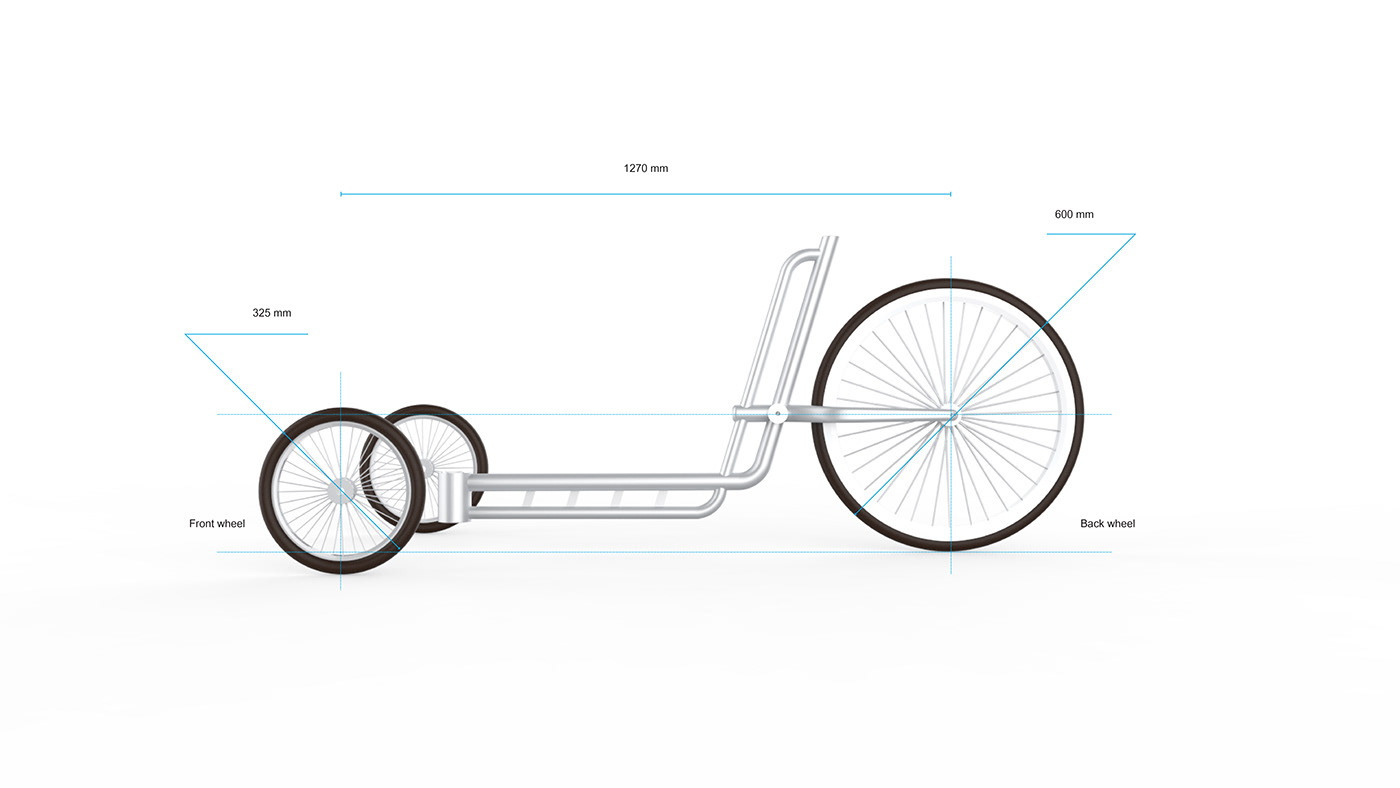
7. Wheel layout & size
Why are the front wheels smaller than the back wheel? To maximize space while maintaining the ergonomic work station height, when the vendor is standing. The base of the unit cannot go below the pivot point of the wheel. The ergonomic work station height for an Indian human is 875-950 mm. So the platform cannot go beyond 950 mm from the ground. If the front wheel is 600 mm, we lose 300 mm below the pivot point of the wheel. While if the wheel is smaller (325 mm), we lose only 162.5 mm below the pivot point. So, smaller wheels give us precisely 137.5 mm more space above the pivot point, which can be used to store more ingredients or merchandise.
Dimensions in play-
1. Work station height: 875-950 mm (36-38 inches)
2. Back wheel diameter: 600 mm
3. Front wheel diameter: 325 mm
2. Back wheel diameter: 600 mm
3. Front wheel diameter: 325 mm

8. Frame
Made entirely out of 1020 steel alloy, it holds the tricycle together. The frame is divided into certain parts according to their functions. This frame is divided into down tube, seat tube & chain stay. Intersection of two smooth lines give an unique form to the frame.
A. Down tube: This part of the frame bears the maximum weight of the entire tricycle. So, the down tube here is reinforced with two pipes & four support structures in-between which leads to the pivot point.
B. Seat tube: As the name suggest, this tube goes up at 73 degrees & leads to the seat. This tube has a support structure to help the down tube take the weight & to increase the stability of chain stay.
C. Chain stay: This one is a fork like structure which keeps the back wheel aligned in the center. It also serves as a connection between the pedal pivot & the gear pivot. It also facilitates the chain mechanism.

9. Garbage bag holder
Instead of making a back seat like a normal bicycle, this one features a frame that can hold garbage bag with help of a rubber band. You can adjust the angle of the holder with the seat clamp. Garbage bags don’t take up much space, so they are easy to carry & once full can be easily replaced. Full garbage bags can be stored in the main storage till they can be disposed.


All work shown is © Studio ABD. Please refrain from editing or modifying the design, or using the concept without prior permission from Studio ABD.
Thank you




